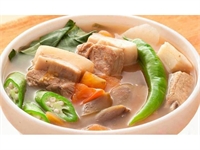
Sinigang (Tangy Filipino Soup)
Important Notice: Our web hosting provider recently started charging us for additional visits, which was unexpected. In response, we're seeking donations. Depending on the situation, we may explore different monetization options for our Community and Expert Contributors. It's crucial to provide more returns for their expertise and offer more Expert Validated Answers or AI Validated Answers. Learn more about our hosting issue here.

Sinigang (Tangy Filipino Soup)
You must be logged in to post a comment.
I Was Saved by Filipino Food Marrying a Filipina was the smartest thing I ever did, for many reasons, not the least of which (but not the most of which by any means, or my wife would kill me) because it introduced me to food from the Philippines.
Most Americans have never tried Filipino food unless they happen to have Filipino friends or co-workers who don’t mind sharing food. This is unfortunate. While most Americans enjoy Chinese food, many are hesitant with other Asiatic foods, such as Japanese, Korean and Vietnamese (I love them all; then again, I think I was an Asian chef in a former life).
However, Filipino food—while it has its similarities to other Asiatic foods—is quite different, and many recipes have been altered subtly or grossly to accommodate American taste buds over the many years that the Philippines was an American territory. The fact is, no Asian country is more Americanized than the Philippines. In fact, English remains the administrative language of the country. As a result, many Filipino dishes will appeal to many if not most Americans.
This delicious, tangy soup can be served as an appetizer at the beginning of a meal, or served over steamed white rice and eaten as a main course, because it is a balanced meal in and of itself.
The most essential ingredient is the tamarind base. Knorr makes a find powdered soup base (sour tamarind and sinigang seasonings are essentially the same). In the Philippines, puritans use real sour tamarind, usually cultivated from their own yards. But this is time consuming and a pain in the butt, which is why most Filipinos use the packets of seasoning, even in the Philippines. Also, mothers make sinigang for their kids when they have colds instead of chicken soup, which makes sense because sour tamarind is loaded with several essential vitamins and minerals, including vitamin C. Personally, I could care less: the stuff tastes damn good, and that’s what matters.
This is my personal take on the classic Filipino dish. According to my wife, no one in the Philippines browns the pork before cooking or uses pork stock to enrich the soup… but then again, I seriously doubt that she knows everyone living in the Philippines. Still, she’s had it the classic way all her life, but prefers my variation, so I must be doing something right.
Sinigang Recipe
For this you will need:
The procedure:
**For improved flavor, use pork stock in this recipe. It’s very easy to make: just buy 3-4 lbs. pork neck bones (and save any bones you may cut out of pork roasts prior to cooking, such as picnic roasts), throw them in a big pot, cover them with water and boil the crap out of them for 3-4 hours over medium-high heat. Strain the broth and store it in glass jars when it cools. It will keep in the fridge for weeks and indefinitely in the freezer. NOTE: a layer of fat will form on top (sometimes a rather thick layer); remove this fat only when you’re ready to use the stock, as it helps to preserve it.